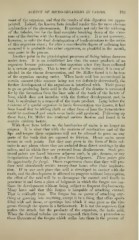Page 753 - My FlipBook
P. 753
AGENCY OF MICRO-ORGANISMS IN CARIES. 763
ment of the organism, and that the results of this digestion are appro-
priated. Indeed, the known facts detailed render this the most obvious
explanation of the phenomenon. It accounts not only for the widening
of the tubules, but for the final complete breaking down of the struc-
ture of the dentine with the formation of a cavity. It is not necessary,
however, to refer the final disintegration of tooth-structure to the action
of this organism alone ; for after a considerable degree of softening has
occurred it is probable that other organisms, so plentiful in the mouth,
may assist in the process.
Another point in the physiological processes of living beings deserves
notice here. It is an established law that the waste products of an
organism become poisonous to that organism when they have collected
in a certain quantity. This is true of urea in the animal, it is true of
alcohol in the vinous fermentation, and Dr. Miller found it to be true
of the organism causing caries. When lactic acid has accumulated in
certain amount (this amount being not yet definitely determined), the
further development of the organisms is interfered with. Their power
to go on producing lactic acid in the depths of the dentine is accounted
for by the formation from the lime salts of the tooth of the lactate of
lime, which does not interfere with the further development, and, in
fact, is equivalent to a removal of the waste product. Ijong before the
existence of a special organism in lactic fermentation was known, it had
been found that by adding chalk or other form of lime the fermentation
could be continued and much more lactic acid produced. Following up
these facts, Dr. Miller has analyzed carious dentine and found it to
contain calcium lactate.
With these facts before us, the localization of caries is no longer an
enigma. It is clear that with the motions of mastication and of the
lips and tongue these organisms will not be allowed to grow on any
parts of the teeth that are exposed to friction. Hence caries never
occurs at such points. But they may grow in the form of little col-
onies in any places where they are secluded from direct washings by the
saliva, and in which they are protected from displacement. Such pro-
tected points are found between adjacent teeth, in pits, fissures, or any
irregularities of form that will give them lodgment. These points give
the opportunity for fungi. Direct experiment shows that they ^vill pro-
duce acid abundantly within twenty-four hours after their implanta-
tion. If in any such place this acid is developed in contact with the
tooth, and the development is allowed to progress without interruption,
the effect of the acid will be to decompose the enamel, and finally to
penetrate it and form a place of lodgment in which the fungus can con-
tinue its development without being subject to frequent dis])lacements.
Many have said that this fungus is incapable of attacking enamel.
That is evidently true. The fungus has no power of attacking any-
thing or growing into anything, except it be a thing that offers spaces
filled with soft tissue, or openings into which it may grow as the vine
grows through the spaces in a lattice-work. It is not the organism that
makes the attack, but the products of the organism, the lactic acid.
When the dentinal tubules are once exposed, they form a protection to
those filaments of the fungus which strike into them in the process of


